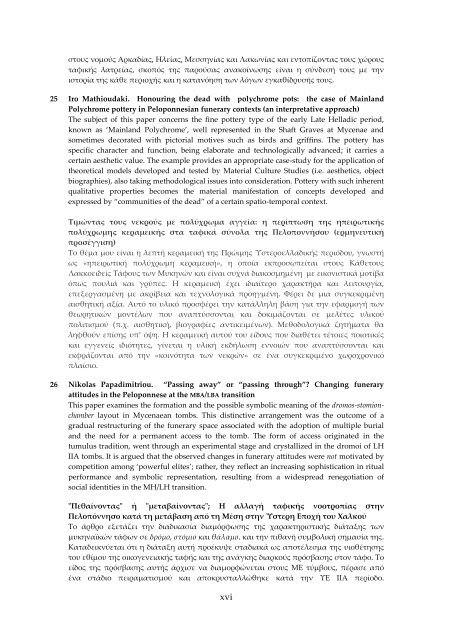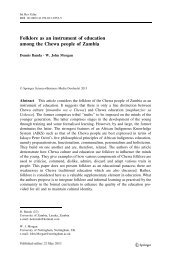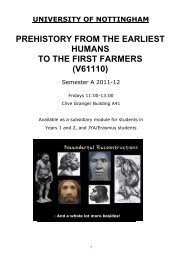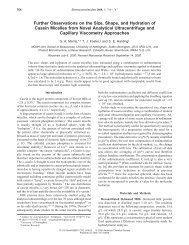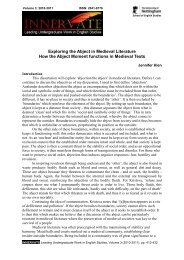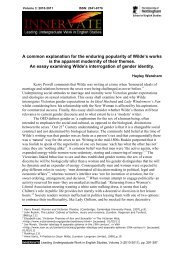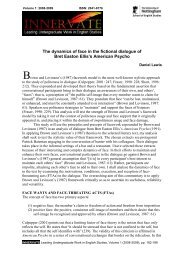Honouring the Dead in the Peloponnese - University of Nottingham
Honouring the Dead in the Peloponnese - University of Nottingham
Honouring the Dead in the Peloponnese - University of Nottingham
Create successful ePaper yourself
Turn your PDF publications into a flip-book with our unique Google optimized e-Paper software.
στους νομούς Αρκαδίας, Ηλείας, Μεσσηνίας και Λακωνίας και εντοπίζοντας τους χώρους<br />
ταφικής λατρείας, σκοπός της παρούσας ανακοίνωσης είναι η σύνδεσή τους με την<br />
ιστορία της κάθε περιοχής και η κατανόηση των λόγων εγκαθίδρυσής τους.<br />
25 Iro Mathioudaki. <strong>Honour<strong>in</strong>g</strong> <strong>the</strong> dead with polychrome pots: <strong>the</strong> case <strong>of</strong> Ma<strong>in</strong>land<br />
Polychrome pottery <strong>in</strong> Peloponnesian funerary contexts (an <strong>in</strong>terpretative approach)<br />
The subject <strong>of</strong> this paper concerns <strong>the</strong> f<strong>in</strong>e pottery type <strong>of</strong> <strong>the</strong> early Late Helladic period,<br />
known as ‘Ma<strong>in</strong>land Polychrome’, well represented <strong>in</strong> <strong>the</strong> Shaft Graves at Mycenae and<br />
sometimes decorated with pictorial motives such as birds and griff<strong>in</strong>s. The pottery has<br />
specific character and function, be<strong>in</strong>g elaborate and technologically advanced; it carries a<br />
certa<strong>in</strong> aes<strong>the</strong>tic value. The example provides an appropriate case-study for <strong>the</strong> application <strong>of</strong><br />
<strong>the</strong>oretical models developed and tested by Material Culture Studies (i.e. aes<strong>the</strong>tics, object<br />
biographies), also tak<strong>in</strong>g methodological issues <strong>in</strong>to consideration. Pottery with such <strong>in</strong>herent<br />
qualitative properties becomes <strong>the</strong> material manifestation <strong>of</strong> concepts developed and<br />
expressed by “communities <strong>of</strong> <strong>the</strong> dead” <strong>of</strong> a certa<strong>in</strong> spatio-temporal context.<br />
Τιμώντας τους νεκρούς με πολύχρωμα αγγεία: η περίπτωση της ηπειρωτικής<br />
πολύχρωμης κεραμεικής στα ταφικά σύνολα της Πελοποννήσου (ερμηνευτική<br />
προσέγγιση)<br />
Το θέμα μου είναι η λεπτή κεραμεική της Πρώιμης Ύστεροελλαδικής περιόδου, γνωστή<br />
ως «ηπειρωτική πολύχρωμη κεραμεική», η οποία εκπροσωπείται στους Κάθετους<br />
Λακκοειδείς Τάφους των Μυκηνών και είναι συχνά διακοσμημένη με εικονιστικά μοτίβα<br />
όπως πουλιά και γρύπες. Η κεραμεική έχει ιδιαίτερο χαρακτήρα και λειτουργία,<br />
επεξεργασμένη με ακρίβεια και τεχνολογικά προηγμένη. Φέρει δε μια συγκεκριμένη<br />
αισθητική αξία. Αυτό το υλικό προσφέρει την κατάλληλη βάση για την εφαρμογή των<br />
θεωρητικών μοντέλων που αναπτύσσονται και δοκιμάζονται σε μελέτες υλικού<br />
πολιτισμού (π.χ. αισθητική, βιογραφίες αντικειμένων). Μεθοδολογικά ζητήματα θα<br />
ληφθούν επίσης υπ’ όψη. Η κεραμεική αυτού του είδους που διαθέτει τέτοιες ποιοτικές<br />
και εγγενείς ιδιότητες, γίνεται η υλική εκδήλωση εννοιών που αναπτύσσονται και<br />
εκφράζονται από την «κοινότητα των νεκρών» σε ένα συγκεκριμένο χωροχρονικό<br />
πλαίσιο.<br />
26 Nikolas Papadimitriou. “Pass<strong>in</strong>g away” or “pass<strong>in</strong>g through”? Chang<strong>in</strong>g funerary<br />
attitudes <strong>in</strong> <strong>the</strong> <strong>Peloponnese</strong> at <strong>the</strong> MBA/LBA transition<br />
This paper exam<strong>in</strong>es <strong>the</strong> formation and <strong>the</strong> possible symbolic mean<strong>in</strong>g <strong>of</strong> <strong>the</strong> dromos-stomionchamber<br />
layout <strong>in</strong> Mycenaean tombs. This dist<strong>in</strong>ctive arrangement was <strong>the</strong> outcome <strong>of</strong> a<br />
gradual restructur<strong>in</strong>g <strong>of</strong> <strong>the</strong> funerary space associated with <strong>the</strong> adoption <strong>of</strong> multiple burial<br />
and <strong>the</strong> need for a permanent access to <strong>the</strong> tomb. The form <strong>of</strong> access orig<strong>in</strong>ated <strong>in</strong> <strong>the</strong><br />
tumulus tradition, went through an experimental stage and crystallized <strong>in</strong> <strong>the</strong> dromoi <strong>of</strong> LH<br />
IIA tombs. It is argued that <strong>the</strong> observed changes <strong>in</strong> funerary attitudes were not motivated by<br />
competition among ‘powerful elites’; ra<strong>the</strong>r, <strong>the</strong>y reflect an <strong>in</strong>creas<strong>in</strong>g sophistication <strong>in</strong> ritual<br />
performance and symbolic representation, result<strong>in</strong>g from a widespread renegotiation <strong>of</strong><br />
social identities <strong>in</strong> <strong>the</strong> MH/LH transition.<br />
"Πεθαίνοντας" ή "μεταβαίνοντας"; Η αλλαγή ταφικής νοοτροπίας στην<br />
Πελοπόννησο κατά τη μετάβαση από τη Μέση στην Ύστερη Εποχή του Χαλκού<br />
To άρθρο εξετάζει την διαδικασία διαμόρφωσης της χαρακτηριστικής διάταξης των<br />
μυκηναϊκών τάφων σε δρόόμο, στόόμιο και θάάλαμο, και την πιθανή συμβολική σημασία της.<br />
Καταδεικνύεται ότι η διάταξη αυτή προέκυψε σταδιακά ως αποτέλεσμα της υιοθέτησης<br />
του εθίμου της οικογενειακής ταφής και της ανάγκης διαρκούς πρόσβασης στον τάφο. Το<br />
είδος της πρόσβασης αυτής άρχισε να διαμορφώνεται στους ΜΕ τύμβους, πέρασε από<br />
ένα στάδιο πειραματισμού και αποκρυσταλλώθηκε κατά την ΥΕ ΙΙΑ περίοδο.<br />
xvi


